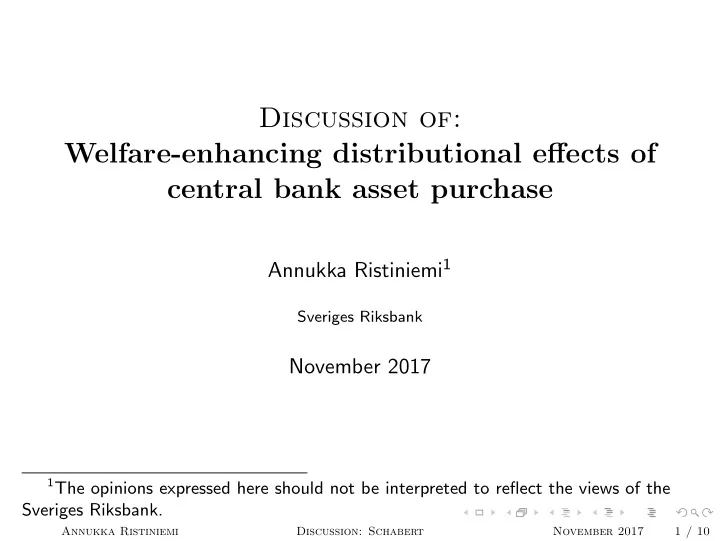

Discussion of: Welfare-enhancing distributional effects of central bank asset purchase Annukka Ristiniemi 1 Sveriges Riksbank November 2017 1 The opinions expressed here should not be interpreted to reflect the views of the Sveriges Riksbank. Annukka Ristiniemi Discussion: Schabert November 2017 1 / 10
Summary of the paper A rich model where money plays an important role. Central bank has several tools at its disposal Heterogeneous households: Need money to buy consumption goods Also a durable good, housing, is a credit good, with limited enforcement. Need to post a collateral (housing) Impatient households borrow to consume, subject to a collateral on housing Central bank: Central bank conducts OMOs at the beginning of the period against treasury bonds at the policy rate to satisfy money demand After preference shocks are realised, can buy collateralised loans from lenders, who can use the proceeds to issue new loans Annukka Ristiniemi Discussion: Schabert November 2017 2 / 10
Summary of the paper Timeline: Households start with an endowment and a consumption plan Can post their holdings of treasury securities at OMO to receive money in order to consume Preference shocks are realised Impatient households borrow additional money from patient households using housing as collateral. Due to limited enforcement, can only pledge a fraction Central bank purchases a random fraction of the collateralised loans, providing more money to the market that can be lent to the impatient households Market for non-durable goods takes place Annukka Ristiniemi Discussion: Schabert November 2017 3 / 10
Results of the paper Pecuniary externalities arise from household heterogeneity: Central bank can alleviate the borrowing constraint through purchases of collateralised loans, and hence improve distribution The magnitude of the effect depends on the policy rate. If the policy rate is too high, lenders are not willing to sell the contracts With a negative aggregate shock, lenders demand for housing falls, leading to less valuable houses, and therefore collateral. Borrowers are hit more, therefore their MU of consumption is higher, and the collateralised loan purchases have a larger effect on the welfare of the borrowers. Annukka Ristiniemi Discussion: Schabert November 2017 4 / 10
Comments Very nice and rich model to study implications of different types of monetary policy Mechanism through which the private asset purchases work through are realistic, and relevant Money demand rises from the need to pay for goods in money Simple, and clear insight that impatient borrowers benefit more from the operation because of higher marginal utility of consumption Annukka Ristiniemi Discussion: Schabert November 2017 5 / 10
Comments Data: assets are concentrated at the hands of the wealthy Figure: In the EA house prices went up, while bond prices rose modestly, and stock prices declined on average. The richest households gained mostly. In the model, assume that all agents have equal amounts of housing at t = 0 With very unequal distribution of housing at the beginning of the period, could have different conclusions on the welfare gains. Figure: ECB annual report 2016 Annukka Ristiniemi Discussion: Schabert November 2017 6 / 10
Comments Scarcity of money: Liquidity premium channel relies on money being important. Is money scarce? Banks create their own deposits, without reserve requirements, reserves do not lead to increased lending: (McLeay, Radia and Thomas, 2014; Kumhof and Benes, 2012) Even with endogenous money creation, liquidity plays a role because of capital requirements, and through reserve induced portfolio balance channel (Christensen and Krogstrup, 2015) However, reserve induced portfolio balance channel is about banks made to hold too much liquidity If the model had banks, would they demand money? Annukka Ristiniemi Discussion: Schabert November 2017 7 / 10
Short comments Title: Title to better reflect private asset purchases, or collateralised debt purchases Annukka Ristiniemi Discussion: Schabert November 2017 8 / 10
Short comments Title: Title to better reflect private asset purchases, or collateralised debt purchases Contribution: Place better in literature: type of asset purchase (MBS), channels through which it operates (liquidity premium) Annukka Ristiniemi Discussion: Schabert November 2017 8 / 10
Short comments Title: Title to better reflect private asset purchases, or collateralised debt purchases Contribution: Place better in literature: type of asset purchase (MBS), channels through which it operates (liquidity premium) Implications for monetary policy in practice: To make it useful for policy, it would need to have a richer structure of the economy and have reasonable calibrated results. Annukka Ristiniemi Discussion: Schabert November 2017 8 / 10
Short comments Title: Title to better reflect private asset purchases, or collateralised debt purchases Contribution: Place better in literature: type of asset purchase (MBS), channels through which it operates (liquidity premium) Implications for monetary policy in practice: To make it useful for policy, it would need to have a richer structure of the economy and have reasonable calibrated results. Potential extension/new paper: Could quite easily study LTROs/funding for lending in the model Annukka Ristiniemi Discussion: Schabert November 2017 8 / 10
Bibliography Christensen, Jens H.E., and Signe Krogstrup (2015) ‘Transmission of Quantitative Easing: The Role of Central Bank Reserves.’ Technical Report Kumhof, Michael, and Jaromir Benes (2012) ‘The Chicago Plan Revisited.’ IMF Working Papers 12/202, International Monetary Fund, August McLeay, Michael, Amar Radia, and Ryland Thomas (2014) ‘Money creation in the modern economy.’ Bank of England Quarterly Bulletin 54(1), 14–27 Annukka Ristiniemi Discussion: Schabert November 2017 9 / 10
Recommend
More recommend